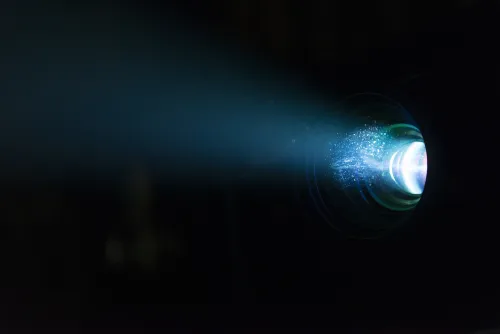Did you know that the first projector was invented in 1879 by Eadwerard Muybridge and its name was Zoopraxiscope? This allowed the development of the early cinema and the projection of cinematographic films.
Now, after almost 150 years, we can say that projection systems are one of the audiovisual solutions we use for content reproduction at corporate events.
This element has evolved significantly in recent decades, providing infinite possibilities and variations when designing an event.
When renting or installing a projection system for a corporate event it will be important to understand some aspects of the kind of events and the characteristics of the space and understand in this way, which is the best option.
It will be necessary to have information on the dimensions, heights, luminosity and other characteristics of the space, as well as the dynamics of the event, the contents to be reproduced, etc.
What is a projector?
A projector is an optical device that receives a video signal and projects the corresponding image into a projection screen or other surface, using a lens system, allowing still or moving images to be displayed.
Main features to consider when renting projectors.
The first point we must to define is the objective of the event. That is, what kind of content you want to reproduce.
There are countless types of events. Therefore, we will not use the same material when we talk about a medical or technological conference, for example, where presentations with many details will be reproduced, that a gala dinner or festival where some videos or visual content are played as background of some music.
Another of the primary needs is to know the luminosity of the space, also depending on the time of day in which the event will be held and if it will be held indoor or outdoor.
In addition, we must pay attention into the measurement of the projection screen on which we are going to project the contents. Maybe it’s another kind of surface, like a wall. On the other hand, we find customized surfaces, facades with mapping projection, etc.
Of course, in order to calculate the type of optics to use for our projector, in addition to knowing the size of the screen, we must to know the projection distance from where the projector is going to be placed to the surface where we are going to project.

Features to consider when renting projectors.
The measure used to measure the brightness of a light is the Lumen. The more Lumens our projector has, the more brightness it will bring.
In the market, there are projectors of great variety of Lumens and not worth any projector in any event or space. We must pay attention to the environmental characteristics of the place where our event is going to take place, to choose the necessary power and brightness.
We must know the ambient lighting of the room or space. If the chosen place cannot be darkened enough, we should probably choose a projector with high lumens, that is, with more brightness.
The projector must have the necessary connectors
The most common inputs found in projectors are: HDMI, VGA, DVI, S-Video, USB-B, composite output and RGB component.
Today, one of the most used connections is HDMI, which supports any video format, but it is not recommended to use a cable of more than 10.00 m, since the image may lose stability.
In addition to projectors and screens renting, we must ensure that we supply and install the necessary wiring according to the objectives, the type of inputs and outputs of the machines, distances, etc. Choosing the right wiring is a very important point when setting up an event.
The best projection technology is DLP.
The technology most used today in room cinemas and corporate events is DLP (Digital Light Processing) for image quality.
This technology was created by TEXAS INSTRUMENTS in the middle of the 1980s and commercialized from the end of the 1990s in video projection.
With DLP projectors, microscopic mirrors arranged in a matrix on a semiconductor chip known as DMD (Digital Micromirror Device) create the image. Each mirror represents a pixel in the projected image. The number of mirrors corresponds to the resolution of the projected image.
These mirrors can be quickly repositioned to reflect light through the lens or into a heat sink.
Get consultancy services from OCTO
If your event requires a projection system, do not hesitate to request information and advice. The characteristics, the kind of event and the location where it will be held, will indicate the necessary options in each occasion.
From OCTO, we target specialized video technicians with extensive knowledge in the domain so that the result is the desired and the most optimal.

